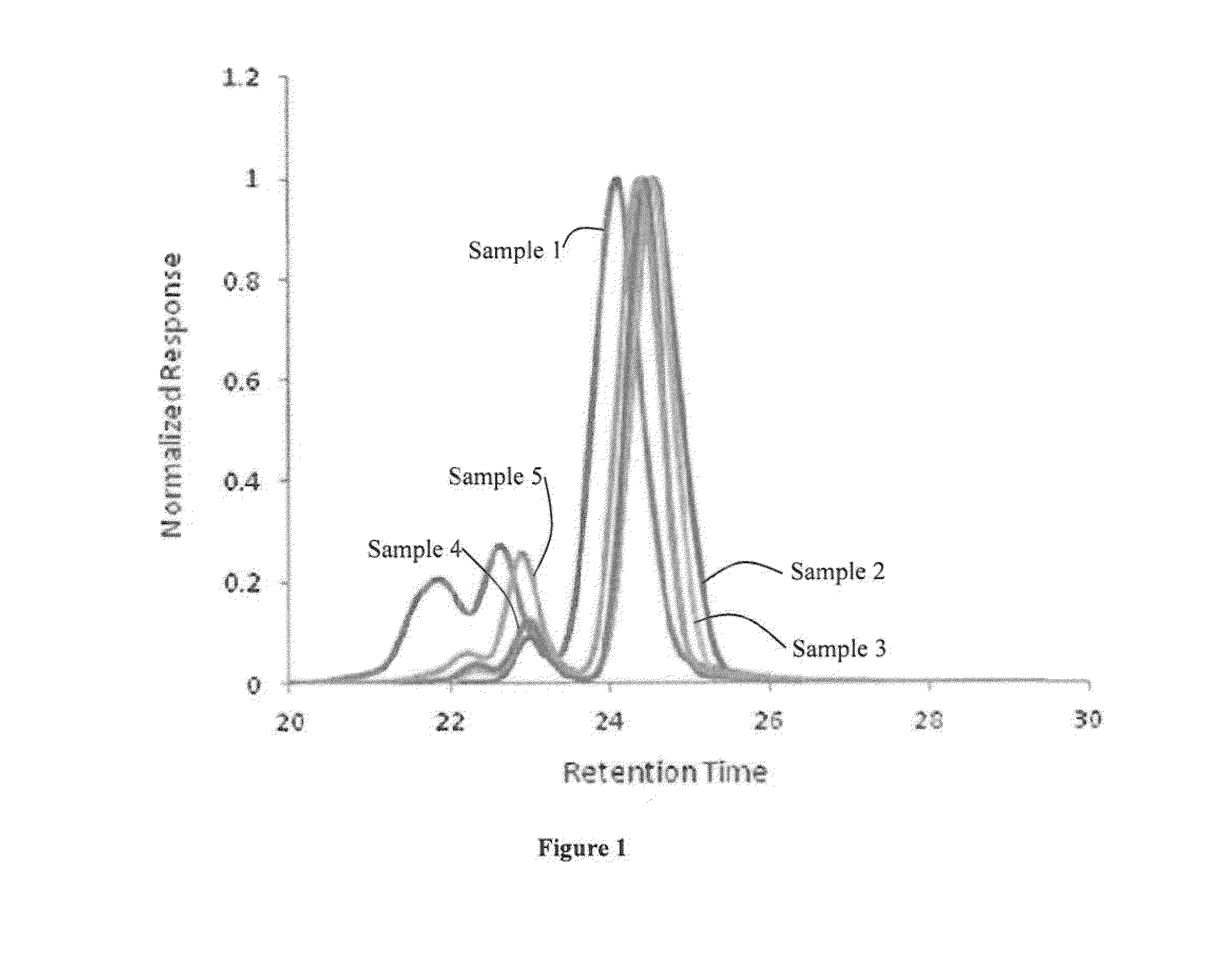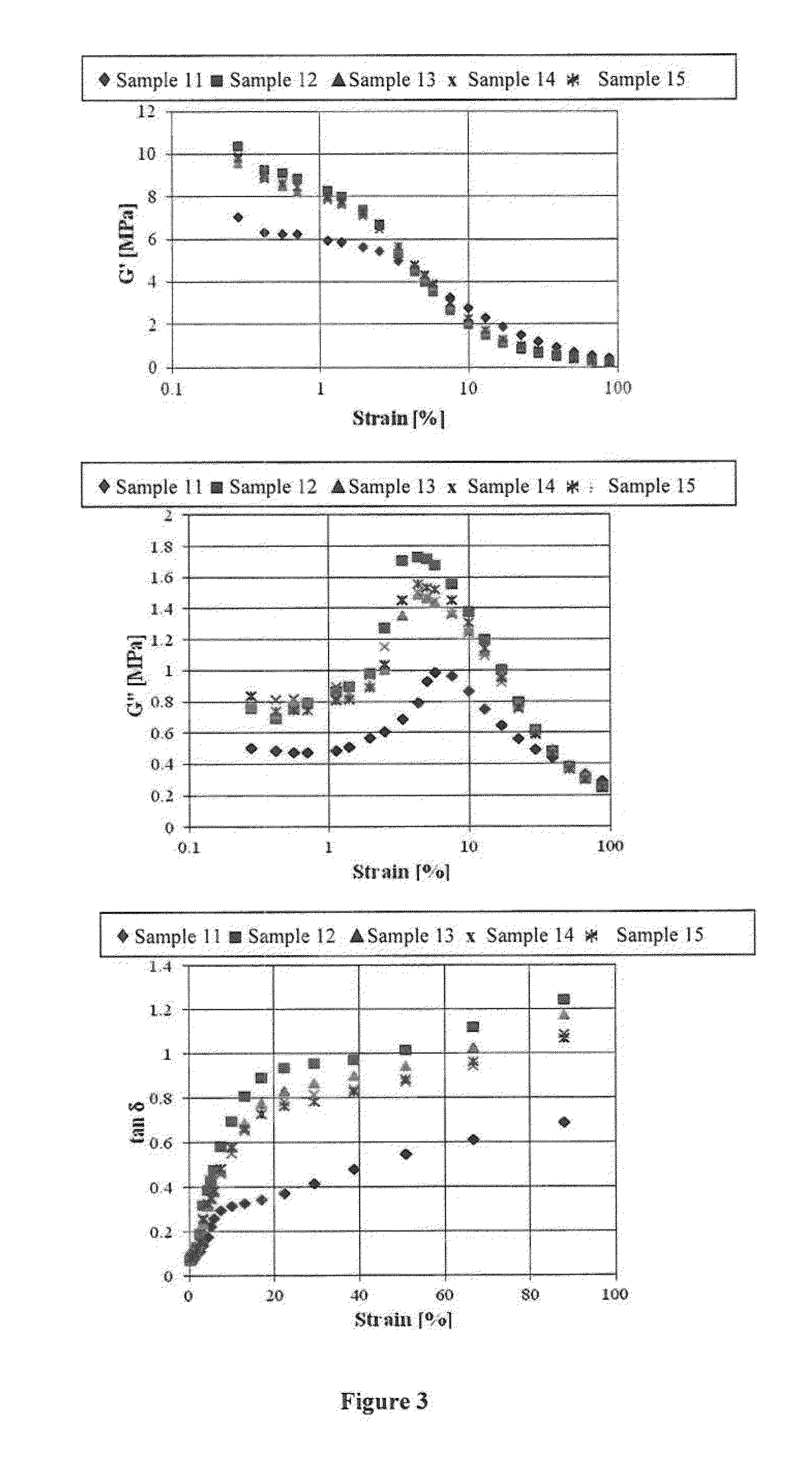Functionalized polymer, rubber composition and pneumatic tire
a technology of functionalized polymers and rubber compositions, applied in special tyres, rolling resistance optimization, transportation and packaging, etc., can solve the problems of low polymer hysteresis and provide a lower level of tire rolling resistance, so as to improve the affinity of fillers and improve the interaction of polymer/filler. , the effect of low cos
- Summary
- Abstract
- Description
- Claims
- Application Information
AI Technical Summary
Benefits of technology
Problems solved by technology
Method used
Image
Examples
example 1
Co-Polymerization of Styrene and Butadiene
[0066]Polymerizations were done in 1 gallon reactor at 65° C. Monomer premix of styrene and butadiene was charged into reactor followed by addition of modifier (TMEDA) and initiator (n-butyl lithium). When conversion was above 98%, the polymerization was terminated with isopropanol or terminating first with ES followed by chlorotriethoxysilane in a cascade reaction. Polymer samples were also synthesized in which termination was done using either ethylene sulfide or chlorotriethoxysilane to see advantage of having functionality from both terminating agent together than individual.
[0067]The synthesis of functionalized polymer as well as control was done in a 1 gallon hatch reactor. The polymer obtained was characterized (GPC results shown in Table 2 and Mooney, FT-IR and DSC results are shown in Table 3) using different techniques, for example, GPC for determination of molecular weight (GPC distribution of different polymer samples is shown in...
example 2
Mixing Studies and Compound Testing
[0068]The functionalized sSBR (functionalized using ES, CTES and both ES&CTES as well as control (non-functionalized SBR) and comparative functionalized SBR) were mixed with silica and oil in a 3-piece 75 mL CW Brabender® mixer equipped with Banbury® rotors.
[0069]sSBR samples were mixed with additives in a three stage mix procedure as shown in Table 3, with all amounts given in parts by weight, per 100 parts by weight of elastomer (phr). In the first non-productive mix stage, compounds were mixed for 4 minutes at 60 rpm using 140° C. as starting temperature. All compounds were pressed in a compression molding machine for 1 minute before a second non-productive mix stage. In the second non productive step mixing conditions were the same as in the first non-productive step, with mix time of 3 minutes. Productive mixes were carried out using 60° C. starting temperature and 60 rpm with mix time of 3 minute.
TABLE 3Formulation used for mixingVariable1 (A...
example 3
[0071]Samples 6-10 were prepared according to Table 3 as non-productive compounds with added silane coupling agent, with no productive mix step.
[0072]FIG. 2 shows the results of the strain sweeps conducted at 40° C. on the non-productive compounds with silane coupling agent after 30 minutes heat treatment of the samples at low strain at 160° C. in the RPA. As shown in FIG. 2, G′ and tan delta of non-functionalized control sample shows highest strain dependency. The functionalized polymer (Comparative) sample shows lowest strain dependency. ES&CTES functionalized polymer samples shows reduced strain dependency, however these polymers have higher tan delta values as compared to Comparative.
[0073]The ratio of the low amplitude (0.48% strain) modulus (LAM) and high amplitude (100% strain) modulus (HAM) which is a measure of the Payne effect and is given in Table 4 for the various samples. Higher the LAM / HAM ratio less is polymer-filler interaction. As seen in Table 4, non-functionalized...
PUM
| Property | Measurement | Unit |
|---|---|---|
| Composition | aaaaa | aaaaa |
Abstract
Description
Claims
Application Information
 Login to View More
Login to View More - R&D
- Intellectual Property
- Life Sciences
- Materials
- Tech Scout
- Unparalleled Data Quality
- Higher Quality Content
- 60% Fewer Hallucinations
Browse by: Latest US Patents, China's latest patents, Technical Efficacy Thesaurus, Application Domain, Technology Topic, Popular Technical Reports.
© 2025 PatSnap. All rights reserved.Legal|Privacy policy|Modern Slavery Act Transparency Statement|Sitemap|About US| Contact US: help@patsnap.com



